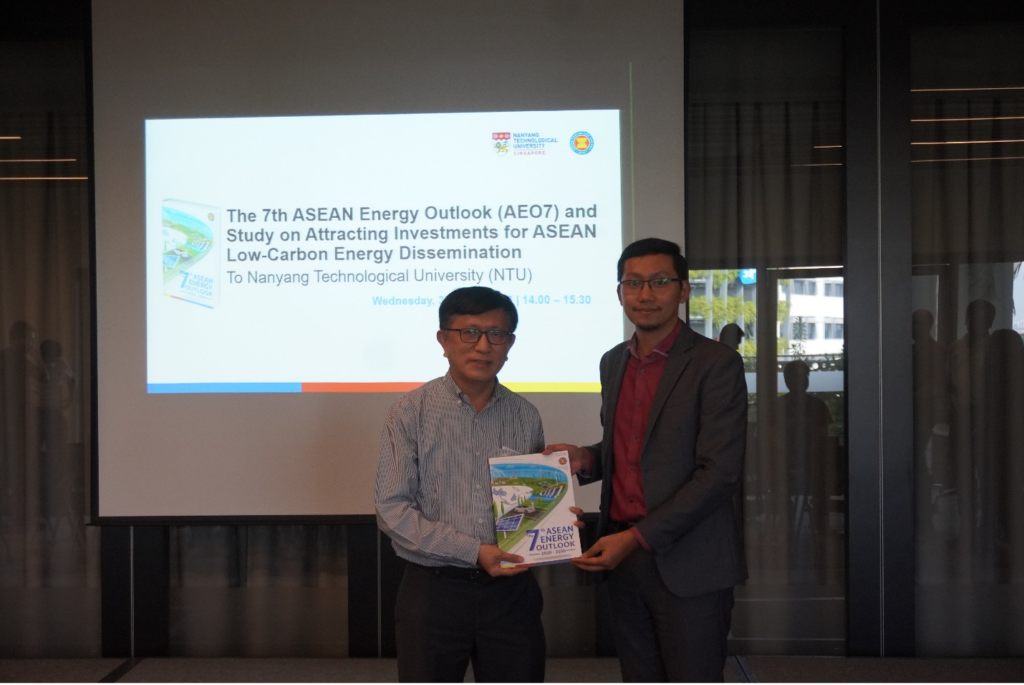Menu

Photo 1. ACE and ERI@N Researchers during the visit to Nanyang Technological University
On 31 May 2023, the ASEAN Centre for Energy (ACE) visited Energy Research Institute at the Nanyang Technological University (ERI@N) for the 7th ASEAN Energy Outlook (AEO7) Roadshow to disseminate its flagship report and disclosure of other study findings on “Investments and Measures for Clean Energy and Power Sector Resilience in ASEAN”, to enrich the upcoming ASEAN Energy Outlook.
Previously, this activity was conducted in Cambodia, Lao PDR, and Malaysia. This time, the dissemination series took place in Singapore as the host of the 22nd Regional Energy and Policy Planning Sub-Sector Network (REPP-SSN) Meeting.

Photo 2. Prof Chan Siew Hwa received a printed copy of AEO7 from Dr Zulfikar Yurnaidi
The NTU delightfully welcomed ACE for organising the event to hear AEO7’s findings and insights first-hand. This was expressed by Prof. Chan Siew Hwa, Co-Director of ERI@N, in his welcoming remarks. Moreover, Dr Zulfikar Yurnaidi, Manager of Energy Modelling and Policy Planning (MPP) of ACE, conveyed his gratitude to the NTU for receiving ACE.
The session started with a presentation from Prof. Chan Siew Hwa concerning ERI@N research expertise and flagship programmes. He also presented NTU’s support for energy transition, such as the solar photovoltaic utilisation over the campus and Singapore’s energy history.
Dr Zulfikar Yurnaidi provided an overview of the ASEAN Energy Outlook (AEO), which provides an overview of the current energy landscape and explores pathways of regional achievement. He emphasised the development of AEO incorporated various data from the ASEAN Member States in the energy sector. ACE launched the 7th edition of the AEO in 2022, offering a new scenario, Least-Cost Optimisation, to explore the potential future in fulfilling the targets of the ASEAN Plan of Action for Energy Cooperation.
Ms Amira Bilqis, Analyst of MPP at ACE, explained the AEO7 modelling findings and the region’s historical and projection energy landscape. The study discovered that regional energy demand is expected to triple by 2050, as industry and transport sectors continue to be the highest energy consumption. Meanwhile, the energy supply in the region remains growing four times by 2050, coinciding with the increasing share of renewable energy. She further elaborated on cross-sectoral findings such as job creation, emissions, and land utilisation.

Photo 3. Presentation on AEO7 findings results
To complement the AEO7 findings, Ms Rika Safrina, Senior Analyst of MPP of ACE, revealed ACE’s recent study on the region’s energy transition investments, supported by the Energy Foundation China. Based on AEO7, the total required investment from 2020-2050 is USD 1070 billion, but the region has limited public finance, which dominates its current financial source of clean energy investment. Within ASEAN, the member states have different progress in clean energy investment, thereby, the study proposed a Roadmap to determine the most concerning issue in their capacity-building programmes for each country.
The presentations led the forum into an extensive discussion about the important role of energy in ASEAN and how the policymakers enable investment-friendly policies for the energy transition. On this occasion, ACE expresses its longing for potential collaboration with the NTU.
